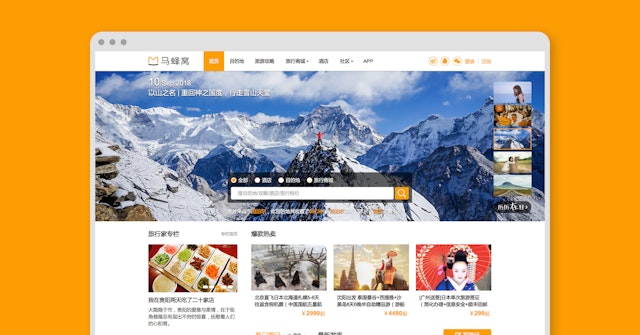China: quietly leading the global customised tourism industry
When UK travel companies are still asking whether they should send customers personalised recommendations, hundreds of thousands of Chinese tourists have already made their holidays a much more personal matter.

Customised travel in China was reserved only for the super rich before 2014, associated with limousines, premium wine, first class flights and five-star hotels. However, the booming economy has given the Chinese middle-class not only a rising spending power but a bigger and more refined appetite for what they want from a holiday – the ability to customise every aspect of their trip, to create an experience that is entirely bespoke to them.
C-trip, China’s biggest leading online travel agency (OTA), recorded 120,000 customised travel orders a month in 2017 through its customised travel platforms including HHtravel – a 400% increase from last year. To meet such high demand, C-trip employs over 5,000 professional ‘customisers’, most of them in their 20s.
As of now the demand and consumption of customised travel as a means of mass travel is rarely seen in the west, even less so among the young consumer groups. But if the tide is bound to change, then, there is definitely a thing or two we can learn from the Chinese tourism industry.

Firstly – remember it’s hard for Chinese tourists to travel outside of Asia. It takes roughly 11 hours to fly from China to Europe. Worse still if you live in a city that doesn’t have direct flights to your destination. And as of today (though there are signs of this changing) all Chinese citizens are required to obtain a visa to visit the majority of European countries.
These limitations dictate that Chinese tourists may not return as often as they wish, so we tend to plan our trips meticulously. This opens up a great opportunity for OTAs, which have grown from traditional travel agencies to a chimera of Lonely Planet-style information platform and lastminute.com.
Starting as a travel forum, such as Mafengwo, many of these platforms garnered followers by curating travel writing from previous travellers and distributing via social media to reach future tourists.

Naturally OTAs transformed into e-commerce, reducing the communication barrier between customers and the service providers.
Service providers (no matter if a registered businesses or freelance tour guides living in the destination countries) can publish information on these platforms and price their services, from short museum tours to 12-day customised once in a lifetime experiences.
In turn, tourists will feedback on their experience via the platform, completing the cycle and gradually building the OTA ecosystem.
The Baidu Index of Chinese Tourism 2017 shows a robust 23% increase of search through mobile devices when it comes to tourism related topics. Built on the omnipresent WeChat and Weibo, the two major social media platforms in China, customised travel agencies can channel their potential customers from content sharing directly to payment, all within a single, efficient and hassle-free user face.
Many platforms launched international editions native to online payment systems, such as Alipay and WeChat Pay, enabling tourists to purchase add-on services before they’ve even arrived at their destination.
The UK is the most popular European destination for Chinese travellers, though ranked only 9th on the ‘most visited European countries’, following Italy, France, Germany, Russia, Switzerland, Austria, Spain and Czech, according to a research done by C-trip and China Outbound Tourism Research Institute (COTRI).
The UK topping the list of most popular destinations is thanks to its abundance of tourism resources, especially education and football. As a culture that values academic achievement, many Chinese parents almost ritually take their children to visit the two most famous universities in the world – Oxford and Cambridge.
This opens up windows for other businesses in the UK who want to appeal to this massive influx of tourists. Here are some suggestions we at Qumin think can be the starter thoughts for your preparation:
- Maintain a social media presence: WeChat has over 1 billion monthly active users, ranking 4th in the world, while Weibo has 350 million, 7th globally. This is where all planning and research starts for Chinese tourists. Think about having a presence here.
- List your businesses on Chinese OTA platforms: It’s not enough to have a social handle if it’s not put to use. Utilise popular OTA platforms to increase your businesses’ exposure to travellers planning their customised trip.
- Better KoLs partnership: The well-monetised KoL industry in China is aggressively lucrative (KoL is a ‘Key Opinion Leader’ – the equivalent of influencer in China). As a result, the cost of a brand-KoL partnership is getting effing expensive. But there are many lesser (and cheaper) KoLs who can have a direct impact on your target audience. Identify them and work with them.
- Be respectful: Chinese tourists have moved past the point where their attention can be grabbed by some poorly made red lanterns and window ads in badly composed Chinese. For UK businesses, if you wish to convert a Chinese passer-by to your customer, treat them with respect.
Arnold Ma is chief executive at Qumin
This article originally appeared in The Drum Network Travel Special. For more information on how to get involved, please contact tehmeena.latif@thedrum.com
Content by The Drum Network member:

Qumin
We are Qumin.
We are a China-focused digital creative agency. We are the first and largest of its kind in Europe.
But that’s not the only thing that...

